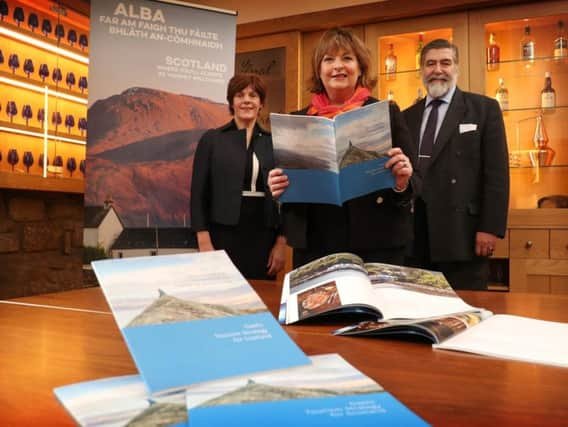Scottish tourism industry urged to 'exploit' Gaelic


Industry leaders have urged businesses to do all they can to capitalise on the centuries-old language and “make more profit out of it”.
The Scottish Government has set out ambitions to “harness the significant economic potential” of Gaelic in a new blueprint setting out how the language should be promoted to visitors.
Advertisement
Hide AdIt wants the industry to place as much as value on the language and culture as Scottish food, drink, tartan, music and landscapes, and see Gaelic as “an asset to be marketed to visitors”.
Campaigners also want to raise much greater awareness of the origins of industry “icons” like tartan, kilts, whisky and bagpipes.
The first-ever Gaelic tourism strategy has been launched after previous research found that one in three visitors said the language had “enhanced” their experiences.
A five-year plan, launched at the Scotch Whisky Heritage Centre in Edinburgh, urges the industry to embrace Gaelic as “a unique selling-point” for Scotland and an authentic part of a visit to the country.
Among the key messages for tourism business is that Gaelic is “not based in myth,” but is part of daily life in Scotland.
Transport operators Caledonian Macbrayne and ScotRail, the Aros, An Lanntair arts centres in Skye, Lewis and Inverness, the Tiree Music Festival , and the Scottish Tourist Guides Association are among the backers of the blueprint.
Advertisement
Hide AdVisitScotland chairman Lord Thurso said there was clear potential for key elements of Scotland’s history and culture to be turned into “commercial opportunities” in future.
He added: “It seems to me that we have a great crown of culture in Scotland which has many jewels in it of all the different things that have marked the passage of the centuries.
Advertisement
Hide Ad“One of the great jewels at the front of the crown is our Gaelic heritage. There is a tremendous opportunity for people to exploit this wonderful natural resource and make more profit out of it.
"Tourism is an economic endeavour. It’s about extracting as much money as possible for the minimum disruption. That means a great product. It’s marvellous to have culture and commerce come together.”
Culture Secretary Fiona Hyslop said: “The Scottish Government’s commitment to preserving and promoting the Gaelic language is clear. But this strategy also has another aim – an aim that is very much about the future.
“That is to recognise and harness the significant economic potential of our Gaelic language and culture and to use that to support our work across all parts of the tourism sector to provide a world-class, high-quality experience for every single visitor.
“We already recognise the immense value of our food and drink, our tartan, our music and literature, our landscapes and more. Gaelic is also an important part of what makes Scotland a unique destination – one that looks to its future, as well as its past."
Shona NicIllinnein, chief executive of Gaelic language agency Bòrd na Gàidhlig, said: “Tartan, kilts, whisky and bagpipes are all from Gaelic culture and have all been adopted by Scotland as international icons, but the links to where they have come from has been lost for most people.
“This is partly because some of the Gaelic culture was adopted and celebrated during the Victorian era, but there wasn’t the same buy-in to the language part of it.”